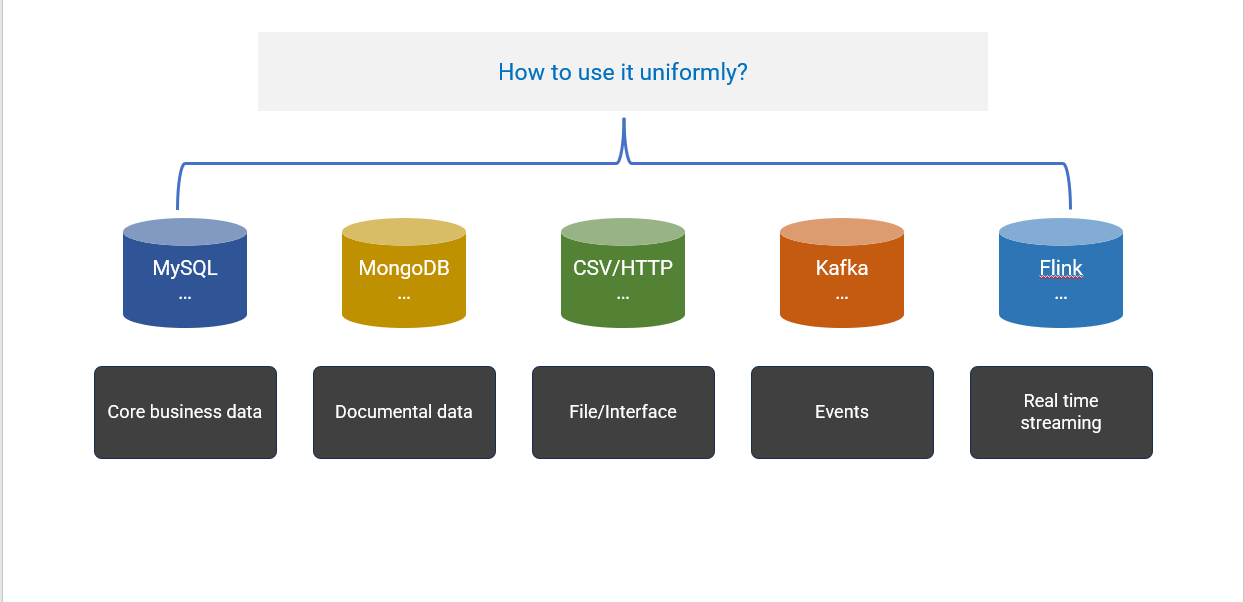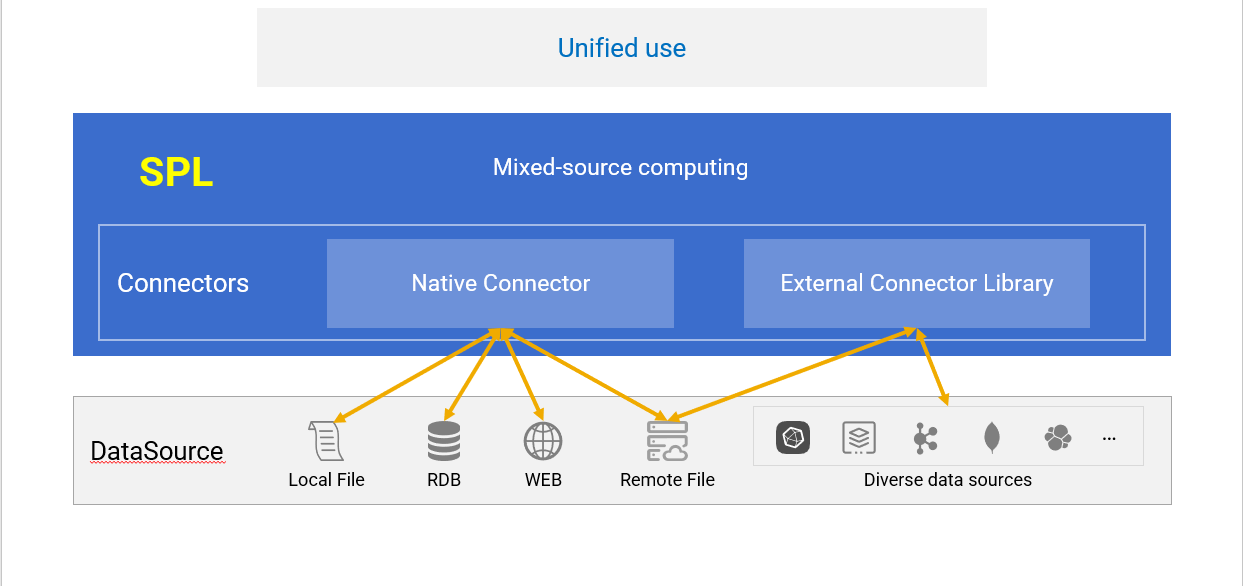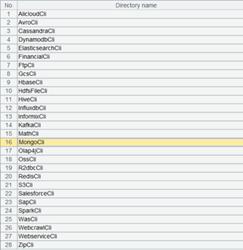SPL Practices:Mixed-Source Computing
Background
The sources and storage forms and types of data in an application are diverse, including not only the traditional relational databases, but also more data sources such as NoSQL databases, cloud storage, APIs, file systems, etc. Therefore, combining and analyzing data originating these different sources constitutes the problem of mixed data source computations.

Logical data warehouses can facilitate mixed-source computations to some extent, because most of them are SQL-based and can access RDB data sources through table mapping. But it is difficult for them to access other types of data sources. Even with the help of complex data virtualization technology, they can only access some of those sources.
Moreover, the logical data warehouse system is too heavy and often more complex than the application itself, making it only suitable for large-scale scenarios.
SPL approach
SPL provides real-time mixed-data source computing capability, enabling mixed-source computations on any accessible data sources. Besides, SPL’s this functionality is very lightweight and can be directly embedded into applications to work.
SPL mixed-source computation framework and characteristics

SPL has two types of data source connectors: native connectors and external connectors. Native connectors, which are built into the SPL core system, include common data sources such as RDBs, text files, Excel files, JSON file, and other local files, as well as HTTP data sources. External connectors encompass various other data sources, such as MongoDB, Kafka, ElasticSearch, and cloud storage, which are not part of the SPL core system and require separate deployment.
Unlike logical data warehouses that use the table mapping, SPL supports and encourages using a data source’s native syntax to access and compute data. If the data source’s computing ability is insufficient, SPL offers supplements, which will be demonstrated in the following examples.
SPL supports a vast variety of data sources. Only some of them, including the most common ones, are listed below:

In which the native connectors can connect to JDBC data sources such as MySQL and Oracle, local files such as CSV, Excel and JSON, web data sources like HTTP and REST API, and remote files, etc.
The external library list includes dozens of uncommon data sources and functions, as shown below:

The external connectors are located in the external libraries, which serve as the extension libraries provided by SPL for holding specialized functions. These functions, which are not commonly used in general scenarios, can be loaded ad hoc from the external libraries as needed.
There are various types of external data sources, and not all are commonly used. Therefore, offering these connectors as external libraries provides greater flexibility, allowing for the timely addition of new data sources without impacting the existing ones in the future.
The vast majority of external libraries are external connectors.
SPL offers two types of data objects for accessing data from sources: table sequence and cursor, which correspond to in-memory data table and streaming data table, respectively.

Almost all data sources, including RDBs, provide such two types of data object interfaces, through which smaller datasets are read all at once into in-memory data tables, and large datasets are retrieved incrementally in the form of streaming data tables. With these two types of data objects, SPL can accommodate nearly all data sources.
Unlike logical data warehouses, SPL does not require pre-defined metadata for mapping. Instead, it accesses data directly using methods provided by the data source and encapsulates data as one of these two types of data objects.
This helps preserve characteristics of the data source and fully leverage its storage and computing capabilities. There is also no need to perform any preliminary data import actions, as real-time access is sufficient. These two types of data objects represent the common capability of diverse data source access interfaces. In contrast, the data table mapping method employed by logical data warehouses fails to adequately abstract the common features of diverse data sources, highlighting a significant difference from SPL.
Next, let’s take a look at the specific uses.
Using SPL in IDE
Configuring data sources
Configure the most common JDBC connection for a native connector within the IDE, like MySQL. Then copy database driver jars to [installation directory]/common/jdbc. Now configure the standard MySQL JDBC connection, as the following figure shows:

Download the corresponding external library driver package (Download) for an external connector, decompress it to any directory, such as [installation directory]\esProc\extlib, and load the external library.
Click on Tool -> Options -> Environment on the IDE menu, and enter the external library directory where you just downloaded and extracted the external library package.

You will see a list of all external libraries. Select the libraries you need to load.

Here, we have chosen MongoDB. After confirming, restart the IDE to take effect.
Use cases
Mixed MongoDB-MySQL query
Our example originates from the e-commerce business and utilizes MySQL to store order-related information. The structures of the two tables involved, orders and order_items, are as follows:
Orders:
| Field | Type | Description |
|---|---|---|
| order_id | INT (PK) | Order ID |
| user_id | INT | User ID |
| order_date | DATETIME | The date when an order is placed |
| total_amount | DECIMAL(10, 2) | Order amount |
Order_items:
| Field | Type | Description |
|---|---|---|
| order_item_id | INT (PK) | Item ID |
| order_id | INT(FK) | Order ID |
| product_id | VARCHAR(20) | Product ID |
| quantity | INT | Purchas quantity |
| price | DECIMAL(10, 2) | Unit price |
These two tables are associated through order_id.
The product information changes as related types – brand, model and specifications for electronics, and brand, size and color for clothing, change, so MongoDB is used to store it. The attributes field accommodates dynamic attributes.
| Field | Description |
|---|---|
| product_id | Product ID (through which data is associated with MySQL) |
| name | Product name |
| brand | Brand |
| category | Category |
| attributes | Dynamic attribute |
The set of products is associated with MySQL via product_id.
These are sample data in MySQL and MongoDB.
Orders:
| order_id | user_id | order_date | total_amount |
|---|---|---|---|
| 1 | 101 | 2024-09-01 | 1999.99 |
| 2 | 102 | 2024-09-02 | 1599.99 |
| … |
Order_items:
| order_item_id | order_id | product_id | quantity | price |
|---|---|---|---|---|
| 1 | 1 | prod_1001 | 1 | 999.99 |
| 2 | 1 | prod_1002 | 1 | 1000.00 |
| 3 | 2 | prod_1003 | 1 | 1599.99 |
| … |
MongoDB:
{
"product_id": "prod_1001",
"name": "Smartphone X",
"brand": "BrandA",
"category": "Electronics",
"attributes": {
"color": "Black",
"storage": "128GB"
}
},
{
"product_id": "prod_1002",
"name": "Laptop Y",
"brand": "BrandB",
"category": "Computers",
"attributes": {
"processor": "Intel i7",
"ram": "16GB"
}
…
}
We want to query the total sales of three product categories – “Tablets”, “Wearables” and “Audio” in the past month. This involves mixed queries across MySQL and MongoDB.
SPL script:
| A | |
|---|---|
| 1 | =connect(“mysql”) |
| 2 | =A1.query@x (“SELECT o.order_id, o.user_id, o.order_date, oi.product_id, oi.quantity, oi.price FROM orders o JOIN order_items oi ON o.order_id = oi.order_id WHERE o.order_date >= CURDATE()- INTERVAL 1 MONTH”) |
| 3 | =mongo_open(“mongodb://127.0.0.1:27017/raqdb”) |
| 4 | =mongo_shell@d (A3, “{ ‘find’: ‘products’, ‘filter’: { ‘category’: {‘$in’: [‘Tablets’, ‘Wearables’, ‘Audio’] } }}” ) |
| 5 | =A2.join@i(product_id,A4:product_id,name,brand,category,attributes) |
| 6 | =A5.groups(category;sum(price*quantity):amount) |
A1 connects to MySQL, then A2 queries the order data within one month using SQL. Option @x indicates closing the connection after querying. The query result is as follows.

A3 connects to MongoDB.
A4 uses mongo_shell function to query and filter data, where @d option indicates returning a table sequence. Function parameters are JSON strings conforming to the MongoDB Command specification, which is the MongoDB native syntax. You can see that the data meeting the criteria is retrieved.

A5 associates the two parts through product_id, and this is the association result.

A6 summarizes the order amount by product type to get the final result. The entire process of implementing the mixed-source computation is straightforward.

Mixed Kafka-MongoDB query
We will then use Kafka to illustrate the computation.
Based on the previous scenario, we use Kafka to publish the order and product information. When the user places an order, the order data will be sent to the order subject by the producer.
Let’s first look at the producer script:
| A | |
|---|---|
| 1 | =kafka_open(“/mafia/my.properties”,“topic-order”) |
| 2 | [ { “order_id”: “1”, “user_id”: “101”, “product_id”: “prod_1001”, “quantity”: 1 }, … ] |
| 3 | =kafka_send(A1, “A101”, A2) |
| 4 | =kafka_close(A1) |
A1 connects to the Kafka server, and the content of the property file my.properties is as follows:
bootstrap.servers=localhost:9092
client.id=SPLKafkaClient
session.timeout.ms=30000
request.timeout.ms=30000
enable.auto.commit=true
auto.commit.interval.ms=1000
group.id=spl-consumer-group
key.serializer=org.apache.kafka.common.serialization.StringSerializer
value.serializer=org.apache.kafka.common.serialization.StringSerializer
key.deserializer=org.apache.kafka.common.serialization.StringDeserializer
value.deserializer=org.apache.kafka.common.serialization.StringDeserializer
A2 is the order data to be sent, which is typically received from a transmitting program. We write it directly here.
A3 sends the order data, and A4 closes the connection.
Next, let’s take a look at the consumer script:
| A | |
|---|---|
| 1 | =kafka_open(“/mafia/my.properties”,“topic-order”) |
| 2 | =kafka_poll(A1) |
| 3 | =json(A2.value) |
| 4 | =mongo_open(“mongodb://127.0.0.1:27017/raqdb”) |
| 5 | =mongo_shell@d(A4,“{‘find’:‘products’}”) |
| 6 | =A3.join(product_id,A5:product_id,product_id,name,brand,category,attributes) |
A2 retrieves consumer records and returns a table sequence. The result is as follows:

A3 converts the JSON string order data to a table sequence:

A5 queries all product data:

A6 obtains all order and product information based on the association via product_id.

At this point, the association between Kafka and MongoDB is completed.
Big data situation
When dealing with large volumes of data, full reading is slow and may lead to memory overflow. In such cases, the cursor mechanism should be adopted to read data gradually in a streaming fashion.
Let’s modify the previous example of mixed MySQL-MongoDB computation:
| A | |
|---|---|
| 1 | =connect(“mysql”) |
| 2 | =A1.cursor@x (“SELECT o.order_id, o.user_id, o.order_date, oi.product_id, oi.quantity, oi.price FROM orders o JOIN order_items oi ON o.order_id = oi.order_id WHERE o.order_date >= CURDATE() - INTERVAL 1 MONTH ORDER BY oi.product_id ASC”) |
| 3 | =mongo_open(“mongodb://127.0.0.1:27017/raqdb”) |
| 4 | =mongo_shell@dc(A3,“{ ‘find’: ‘products’, ‘filter’: {}, ‘sort’: {‘product_id’: 1}}”) |
| 5 | =joinx(A2:o,product_id;A4:p,product_id) |
| 6 | =A5.groups(p.category;sum(o.price*o.quantity):amount) |
A2 changes the original “query” to “cursor”, which returns a cursor object without truly fetching the data.

Using the @c option in A4 means that the queried MongoDB data also returns as a cursor, and the result is also a cursor object.
A5 uses joinx() function to associate two cursors, which necessitates that both cursors be ordered by the joining fields. For this reason, a sorting operation is performed in both A2’s SQL and the MongoDB command in A4.
The association result of A5 is still a cursor. If fetch is used to retrieve data, we can see that the actual result is a multi-layer table sequence.

A6 performs aggregation by category and obtains the result. It is only at this point that data is fetched and computed for all cursor operations.

The SPL cursor can be used to handle big data situations involving almost any data sources.
Using SPL within the application
Let’s look at how to use SPL in an application.
Integration with the application
It is simple to integration SPL with an application. We just need to import the two jars – esproc-bin-xxxx.jar and icu4j-60.3.jar – under* [installation directory]\esProc\lib* to the application, and then copy raqsoftConfig.xml under* [installation directory]\esProc\config *to the application’s class path.
raqsoftConfig.xml is the key configuration file of SPL, and its name cannot be changed.
Configure the external library in raqsoftConfig.xml as needed. To use MongoDB and Kafka, for example:
<importLibs>
<lib>KafkaCli</lib>
<lib>MongoCli</lib>
</importLibs>
At the same time, the MySQL data source also needs to be configured here. Configure the connection information under the DB node:
<DB name="mysql">
<property name="url" value="jdbc:mysql://127.0.0.1:3306/raqdb?useCursorFetch=true"/>
<property name="driver" value="com.mysql.cj.jdbc.Driver"/>
<property name="type" value="10"/>
<property name="user" value="root"/>
<property name="password" value="root"/>
<property name="batchSize" value="0"/>
<property name="autoConnect" value="false"/>
<property name="useSchema" value="false"/>
<property name="addTilde" value="false"/>
<property name="caseSentence" value="false"/>
</DB>
Invocation by Java
SPL encapsulates the standard JDBC interface. Load the SPL driver and then call the SPL script using call SPL method via JDBC.
public static void main(String[] args) {
String driver = "com.esproc.jdbc.InternalDriver";
String url = "jdbc:esproc:local://";
try {
Class.forName(driver);
Connection conn = DriverManager.getConnection(url);
PreparedStatement st =conn.prepareCall("call mongo_join_mysql()");
st.execute();
ResultSet rs = st.getResultSet();
while (rs.next()) {
String category = rs.getString("category");
System.out.print(category+",");
}
} catch (Exception e) {
throw new RuntimeException(e);
}
}
This part of code is consistent with typical database JDBC calls to stored procedures, so we will not elaborate further.
That’s all about handling mixed-source computing in SPL.
We have only demonstrated the mixed computations involving only a few data sources here. However, SPL supports a wide range of data sources and they can be further extended.
SPL offers unified data objects, and thus can easily implement any mixed computations as long as it can access the data sources.
SPL is now open-source. You can obtain the source code from GitHub in https://github.com/SPLWare/esProc
SPL Official Website 👉 https://www.scudata.com
SPL Feedback and Help 👉 https://www.reddit.com/r/esProcSPL
SPL Learning Material 👉 https://c.scudata.com
SPL Source Code and Package 👉 https://github.com/SPLWare/esProc
Discord 👉 https://discord.gg/2bkGwqTj
Youtube 👉 https://www.youtube.com/@esProc_SPL



Chinese version